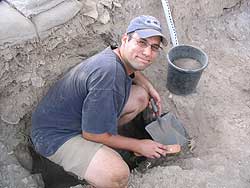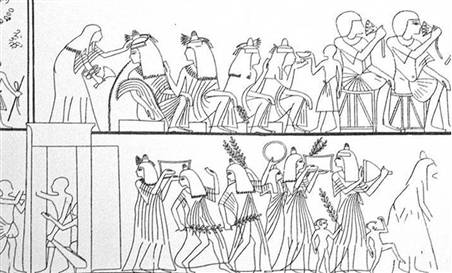A recent news release on Eureka Alert summarizes a forthcoming article in Revue de Qumran on a remote latrine site discovered at Khirbet Qumran.
This is the fifth in a series of posts (some more serious than others) on “Going Potty in the Ancient World.� My other posts include:
All posts in this series may be viewed here.
The international team of scholars, including James Tabor, Joe Zias, and Stephainie Harter-Lailheugue, did a number of soil samples outside of the Qumran settlement and discovered a latrine site.
Here is an excerpt:
Visiting Qumran, Tabor noted an area approximately 500 meters to the northwest of the settlement which seemed likely because it was sheltered from view by a bluff. Tabor also noted that the soil in the area appeared to have a significantly different coloration from other soils in the Qumran environs, a fact which was subsequently confirmed by Zias using high-resolution aerial photographs.
“I started thinking that in the scrolls they have these very explicit descriptions of where the latrines have to be,” Tabor explained. “It has to do with religious ritual purity — the latrines have to be located in a place that the ancient texts designate as ‘outside the camp’. That’s a phrase used in the Torah, where Moses tells the ancient Israelites ‘build your latrines outside the camp.’ When you go to the toilet, take a paddle or a shovel with you and use the toilet and then cover it up,” he said, explaining that the ancient practice appears to have been revived at Qumran.
“This group is very strict and they observe this practice rigorously — in one text it says go 1000 cubits, and in another text, 2000 cubits — and they specifically state ‘northwest’ in the scrolls. Josephus, in talking about the Essenes, mentions it as a point of admiration or piety – he says that these people are so holy, that on the Sabbath day they won’t even use the toilet, because on the Sabbath one can’t go outside the settlement,” he said.
“It turns out, if you go northwest from Qumran you get to this bluff – a large natural plateau separated from further cliffs – and if you go around it, it hides you from the camp. One of the things Josephus says is that they also believe that their latrines should shield them from view of the camp, so I thought ‘this is getting really good, if I can just find some evidence for toilet practices.'”
Tabor suggested investigating the area to Zias, who took four random soil samples at the site as well as six other samples for control — 4 from surrounding desert areas, one from an area that was known to be Qumran’s stable (to test for animal parasites), and one from an area on the opposite side of the city, essentially covering other outside-the-settlement areas that could have been used as latrines.
On the basis of earlier research that has shown that intestinal parasites can be preserved in arid, sub-surface conditions, Zias sent the samples to Harter-Lailheugue at CNRS for analysis. Three of the four samples from the suspected latrine area yielded four species of preserved worm eggs and embryophores that were all identified as human intestinal parasites – Ascaris SP. (human roundworm), Taenia SP. (a human tapeworm), Trichuris SP. (a human whipworm) and a human pinworm, Enterobius vermicularis, that had not previously been reported in the ancient Near East. The soil sample from the stable contained the eggs of Dricrocoelium SP., a common parasites of ungulates. The control samples from the surrounding desert areas contained no parasites, human or animal.
“Frankly, I was surprised,” said Zias. “A parasitologist I talked to told me that my chances of finding something were just about nil. Finding evidence of parasites would be easy in a latrine, but in the middle of the desert… But small things like parasite eggs in feces can hang around for thousands of years. At the Dead Sea, we have hair and hair combs with desiccated lice in them because of the dryness.”
“The evidence shows conclusively that the area was a toilet,” Zias noted. “The samples contained eggs from intestinal worms that are specific to humans. These things had to come from human feces. The presence of eggs in three out of four 100-gram samples indicates heavy and continual use of the specific site suggested by Tabor.”
Since the other sites did not yield human parasites, the team concluded that the latrine site was most likely the area specified in the Scroll passages. Because of the remoteness of the Qumran environs, they concluded that the latrine could only be associated with Qumran, the only settlement in the area.
The scroll texts that provide the directives for going potty at Qumran which the article alludes to are found in the War Scroll and the Temple Scroll. The latter scroll contains the directives to build the latrines “outside the city” חוץ מן העיר (see 11QT 46.13), while the former gives further directions about the latrines and that they should be in discrete and private locations (1QM 7.7; see also 4Q491 frg 1, 3.7) (see also Deut 23:12-13).
This discovery accords well with the reported bathroom habits of the ancient Essenes and may be another piece of evidence supporting the Essene hypothesis, which has come under attack in recent years (see, for instance, my post Khirbet Qumran and the Dead Sea Scrolls). The discovery of a latrine site also makes sense of the fact that only one toilet was found in the actual Qumran site (see my initial post on the Qumran toilet in GPAT 1).
The rest of the press release goes on to highlight some of the implications about the unsanitary conditions at Qumran on the health of the inhabitants and their apparent short lifespan as illustrated by the remains at the cemetery.
I am looking forward to the full article in Revue de Qumran. In the meantime, take a gander at the news report.
This discovery has also hit the major internet news sources, including the NY Times, MSNBC, the Jerusalem Post, Nature.com, among others.
(HT Archaeologica News)
 Ken Ristau (of anduril.ca fame) has written some reflections on his six-week participation in the Renewed Tel Dor Project this last summer. The Tel Dor excavations were renewed in 2003 and are directed by Ilan Sharon (Hebrew University) and Ayelet Gilboa (University of Haifa).
Ken Ristau (of anduril.ca fame) has written some reflections on his six-week participation in the Renewed Tel Dor Project this last summer. The Tel Dor excavations were renewed in 2003 and are directed by Ilan Sharon (Hebrew University) and Ayelet Gilboa (University of Haifa).
